Project Management Concepts
The phrase project has broad connotation. It is achieved through sequence of activities. A project is definite task that has a definable starting and a definable conclusion and needs one or more resources to finish its constituent activities, which are consistent and which must be accomplished to realize the objectives of the project. A project is a group of unique, inter-related activities that are planned and executed in a certain sequence to create a unique product or service, within a specific time frame, budget and the client's specifications.
Project Management Institute's described a Project as "A temporary endeavour undertaken to create a unique product or service" According to The British standard defines a project as "A unique set of coordinated activities, with definite starting and finishing points, undertaken by an individual or organization to meet specific objectives within defined schedule, cost and performance parameters". Little and Mirrless described that a project is any scheme or part of a scheme for investing resources which can be reasonably analysed and evaluated as an independent unit.
Each project is exclusive in the sense that the activities of a project are unique and non-routine.
Major component of project charter: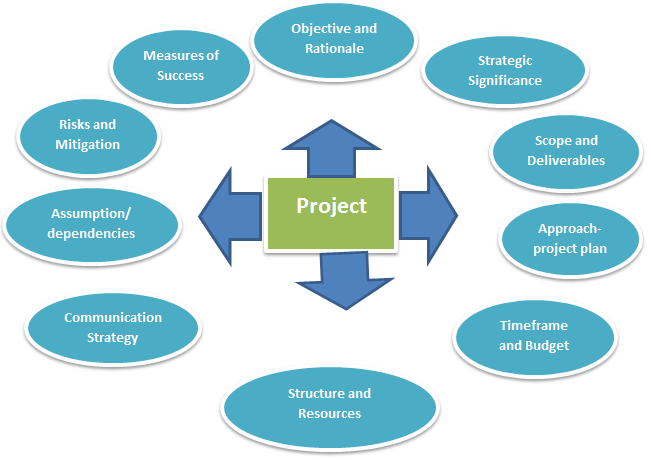
The prominent features of a project include:
- A project has identifiable beginning and end points.
- Each project can be broken down into a number of identifiable activities which will consume time and other resources during their completion.
- A project is scheduled to be completed by a target date.
- A project is usually large and complex and has many interrelated activities.
- The execution of the project activities is always subjected to some uncertainties and risks.
- Uses restricted resources.
Project management is developed to synchronize and control all project activities in a well-organized and cost effective manner. Project management is a structured venture for managing projects. Project management involves technical application of contemporary tools and techniques in planning, financing, implementing, monitoring, controlling and synchronizing unique activities or tasks to generate desirable outputs in accordance with the pre-determined objectives within the constraints of time and cost. According to PMI, "Project management is the application of knowledge, skills, tools and techniques to project activities in order to meet or exceed stakeholder needs and expectations".
Project management includes defining project goals, specifying how the goals will be accomplished, what resources are needed, and relating budgets and time for completion. Major objectives of project management are to coordinate the various interrelated processes of the project, ensure project includes all the work required, and only the work required, to complete the project successfully, make sure that the project is completed on time and within budget, ensure that the project will gratify the needs for which it was undertaken, ensure the most effective use of the people involved with the project, promote effective communication between the projects team members and key stakeholders and ensure that project risks are identified, analysed, and responded.
Theoretical review of project management: According to project management book of knowledge guide, projects are composed of two kinds of processes that include project management process and project oriented process. It is documented in literature that project management was done since early civilization, Egyptian era. Until 1900, civil engineering projects were successfully managed by architects. From 1950s, organizations systematically applied project management tools and techniques to complicated engineering projects. Project management has been applied in several disciplines such as civil construction, heavy defence activity and engineering. In the 1950s, Navy employed modern project management methodologies in their Polaris project. During the 1960s and 1970s, Department of Defense, NASA, and large engineering and construction companies utilized project management principles and tools to manage large budget, schedule-driven projects. In the 1980s, manufacturing and software development sectors started to adopt and implement modern project management practices. In the decade of the 1990, the project management theories, tools, and techniques were extensively received by different industries and organizations.
Four periods of project management
Henry Gantt was known as father of planning and controlling project management techniques and used Gantt chart as a tool for project management. Henri Fayol created five function of project management. During this period, two project management models were developed including critical path method with joint venture between Du pont.
Project management is a challenging process with many multifaceted responsibilities. There are many tools available to assist with accomplishing the tasks and executing the responsibilities.
Some require a computer with supporting software, while others can be used manually. Project managers should select a project management tool that best suits their management style. Program Evaluation Review Technique (PERT) and Gantt Charts are effective project management tools (Cook, 2005). Both of these project management tools can be produced physically or with commercially available project management software.
Program Evaluation Review Technique of network diagram show logical relationships among the task without time scale. PERT planning has following steps:
First is to identify the specific activities and milestones. The activities are the tasks of the project. The milestones are the events that mark the beginning and the end of one or more activities.
Secondly, determine the proper sequence of activities. This step may be combined with first step since the activity sequence is evident for some tasks. Other tasks may require some analysis to determine the exact order in which they should be performed.
Third is to draw a network diagram. Using the activity sequence information, a network diagram can be drawn showing the sequence of the successive and parallel activities.
Fourth is to estimate the time required for each activity. Weeks are a commonly used unit of time for activity completion, but any consistent unit of time can be used. A distinctive feature of PERT is its ability to deal with uncertainty in activity completion times. For each activity, the model usually includes three time estimates such as Optimistic time - the shortest time in which the activity can be completed, most likely time - the completion time having the highest probability and Pessimistic time - the longest time that an activity may take.
PERT chart is beneficial because it improves planning and scheduling of activities, improves forecasting of resource requirements. It identifies repetitive planning patterns which can be followed in other projects, thus simplifying the planning process. PERT chart has ability to see and thus reschedule activities to reflect inter project dependencies and resource limitations following identify priority rules.
Typical network diagram (Source, Cook, 2005)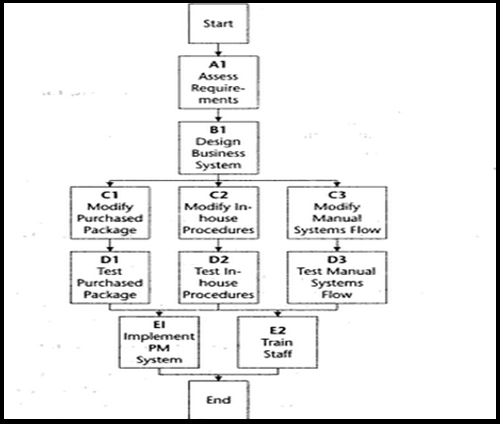
Another effective tool of project management is Gantt charts which are used to display calendar time task assignments in days, weeks or months. The tool uses graphic representations to show start, elapsed, and completion times of each task within a project. Gantt charts are best for tracking growth (Cook, 2005). These charts serve as a valuable budgeting tool and can show dollars allocated versus dollars spent. For drawing Gantt chart, there are several steps such as
- List all activities in the plan. For each task, show the earliest start date, estimated length of time it will take, and whether it is parallel or sequential. If tasks are sequential, show which stages they depend on.
- Head up graph paper with the days or weeks through completion.
- Plot tasks onto graph paper. Show each task starting on the earliest possible date. Draw it as a bar, with the length of the bar being the length of the task. Above the task bars, mark the time taken to complete them.
- Schedule activities. Schedule them in such a way that sequential actions are performed in the required sequence. Make sure that dependent activities do not start until the activities they depend on have been completed. Where possible, schedule parallel tasks so that they do not interfere with sequential actions on the critical path. While scheduling, ensure that researchers make best use of the resources they have available, and do not over-commit resources. It is suggested to allow some slack time in the schedule for holdups, overruns, failures.
- Presenting the analysis. In the final version of Gantt chart, combine draft analysis with scheduling and analysis of resources. This chart will show when scholars forestall that jobs should start and finish.
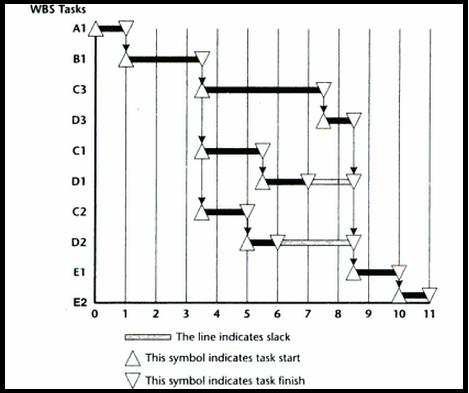
Major benefits of using Gantt chart as a project management tools are that it gives an easy to understand visual display of the scheduled time of a task or activity, makes it easy to develop "what if" scenarios, enables better project control by promoting clearer communication, becomes a tool for negotiations, shows the actual progress against the planned schedule, can report results at appropriate levels, allows comparison of multiple projects to determine risk or resource allocation and rewards the project manager with more visibility and control over the project.
Project Management Constraints: A project must be completed under three constraints.
- Scope – project size, goals and deliverables.
- Time – time frame available to complete the project.
- Cost (or Budget) – amount budgeted for the project.
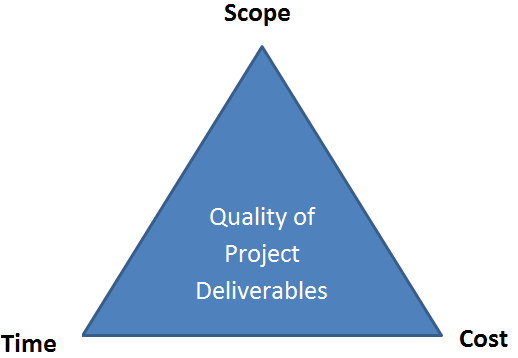
In above figure, each constraint signifies a side of the triangle. Inside the triangle is the quality of the project deliverable(s). While arguable as far as whether quality is an actual constraint of a project, it is the direct result of the competing project priorities and is an important factor at the forefront of any information technology project. Each project constraint is in direct competition or conflict with another. Therefore, changing one constraint has a direct impact on the others. In almost all projects, the goal is a high quality deliverable within a fixed time frame, at the predetermined cost.
Project management comprises of following:
Skill: It is established that set of skill, expert knowledge, and experience are the need to reduce the level of risk in project management.
Tool: A suite of tools are used by project manager to get success such as document templets, register, planning software, modelling software, audit checklist and review forms.
Processes: Various management techniques and processes are needed to monitor and control time, cost quality and scope on project.
Project life cycle is logical sequence of activities to attain project goals. According to Patel and Morris, the life cycle is the only thing that differentiates projects from non-projects (2004).
Project management comprises of the following phases.
Phase I: Conception and Selection
Phase II: Planning and Scheduling
Phase III: Implementation, Monitoring and Control
Phase IV: Evaluation and Termination
Project life cycle with measurement points (Source: Kloppenborg, 2011)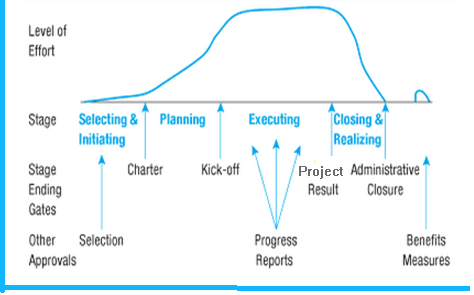
- Project Initiation: The business problem or opportunity is recognised and a business case is developed. All stakeholders come together to establish preliminary agreement around project scope, costs, and expected timelines.
- Project Planning – Project plans are established outlining activities, resource requirements, tasks, project deliverables, etc. A preliminary project schedule is conscripted.
- Project Execution: In this phase, customer requirements are gathered, a solution is agreed upon by all stakeholders and/or selection/procurement begins. While the actual project plan is being executed, a series of management processes are also underway to monitor and control project progress and deliverables and to ensure the project stays on track.
- Project Monitoring and Control: In this phase, frequently measuring and monitoring project progress and making sure that project objectives are on track and being met. Variances from the project plan are identified and corrective action is taken when necessary.
- Project Closure: During this phase, the project is delivered to the client. A post-implementation review is conducted to determine the level of success of the project and to highlight key lessons learned for future projects.
It is well established that project management is intricate process. To understand how and why IT projects fail is to determine the outcome of a project. Major grounds for project failure are as follows:
- Project sponsors are not committed to the project objectives.
- Business needs are not clearly defined (i.e. incomplete/changing requirements).
- Incomplete project scope and unrealistic expectations.
- Absence of a project plan.
- Lack of resources (i.e. people, technology, money, time frame).
- Inappropriate methodology or project approach.
- Too many people working on the project – no project synergy.
In simple way, project management understanding is all about planning. Proper planning can be somewhat complicated, and to do it well requires delving into what needs to be done from the starting. Although the practice of project management has been done from centuries, researchers and project management professionals are still exploring the effective process of project management. The value of face-to-face interaction does not deteriorate, even with the deployment of virtual project management teams. Projects require leaders who are trained in both business and technology and have teams with qualified project management professionals when possible. There are various preferences and cultural values that weigh different communication techniques and interpersonal skills differently. Perceptions of communication techniques will have an impact on the end user and the end result of the project, so it is important to clarify preferences at the beginning.
To summarize, Project management is effective method of planning, organizing, motivating, and controlling resources, procedures and protocols to accomplish established goals in technical way. Project management needs experts to apply their personal knowledge, skills, tools, and techniques towards an activity in order to fulfil the requirements of a project assigned. Top organizations across sectors and geographic borders have been steadily embracing project management as a way to control spending and improve project results.
project management

